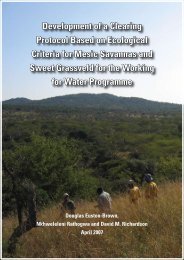Metsi Consultants - DWA Home Page
Metsi Consultants - DWA Home Page
Metsi Consultants - DWA Home Page
You also want an ePaper? Increase the reach of your titles
YUMPU automatically turns print PDFs into web optimized ePapers that Google loves.
Report No 678-F-001<br />
METSI CONSULTANTS: SUMMARY OF MAIN FINDINGS FOR PHASE 1 DEVELOPMENT<br />
13.2. ASSESSMENT OF INSTREAM FLOW REQUIREMENTS IN SOUTHERN AFRICA<br />
13.2.1 Lesotho<br />
This report describes the IFA carried out for the rivers below existing and planned LHWP Dams using the DRIFT<br />
methodology to develop scenarios for decision-making. Each scenario describes a possible future flow regime,<br />
and the consequences for river health and for subsistence users of the rivers. This has been the largest and most<br />
comprehensive IFR assessment to date in Africa and involved an international team of 27 scientists from 19<br />
disciplines over a 2-3 year period. The consequences of each of four flow scenarios has been predicted on the<br />
basis of existing knowledge and twelve months of fieldwork, during which time the specialists collected river data<br />
specific to their field of expertise. The input of each specialist team has been integrated using the DRIFT<br />
methodology to produce the scenarios of predicted consequences.<br />
13.2.2 South Africa<br />
IFAs have been researched and implemented in South Africa for over 10 years, and were initiated in the mid-<br />
1980s by the <strong>DWA</strong>F to manage the health of aquatic ecosystems. Habitat-simulation methods were found<br />
unsuitable for several reasons and the BBM was developed as an approach where time, finances and biological<br />
data were limited. This approach has to date been used to determine comprehensive IFRs for more than 20 rivers<br />
in South Africa and was the basis upon which environmental protection of aquatic resources was built into the<br />
South African Water Act of 1998, recognized at the time of promulgation as one of the most advanced in the<br />
world.<br />
The South African Water Act recognizes only two rights to water, which have to be met before any other water<br />
demand is catered for. These are jointly called the Reserve. The 'Basic Human Needs Reserve’ allocates water<br />
per capita for basic drinking, washing and cooking purposes, while the 'Ecological Reserve’ recognizes the need<br />
to protect the health of the aquatic systems that are the basis of water and other linked resources. The Reserve is<br />
determined for all rivers on which development is proposed and is currently being estimated for the Thukela River<br />
in Kwazulu-Natal.<br />
13.2.3 Swaziland<br />
IFR determination in Swaziland commenced with the Maguga Dam on the Komati River, the fourth largest dam in<br />
southern Africa (behind Kariba, Cohora Bassa and Katse). The Komati River has been subjected to a<br />
comprehensive IFA, using the BBM.<br />
13.2.4 Mozambique<br />
Limited environmental flow studies have taken place in Mozambique. A basic desktop assessment has been<br />
done for the Joint Inkomati Basin Study for the water departments of South Africa, Swaziland and Mozambique.<br />
The retention of Zambezi River floods by the Cohora Bassa Dam has impacted on downstream river ecosystems,<br />
resulting in losses of fisheries, agriculture and grazing and causing floodplain recession. Although no formal IFAs<br />
have yet been undertaken in the country, interest in implementing IFRs is growing and proposals have been<br />
made for an extensive research programme for the rehabilitation of the Zambezi delta, which would involve reestablishment<br />
of a flood regime for downstream rivers and subsistence economies.<br />
74

















